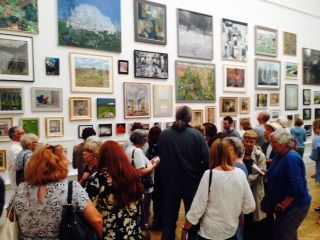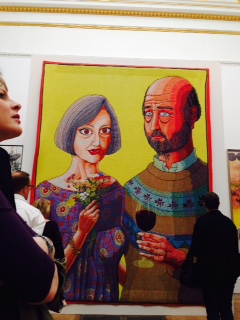AUGUST CHALLENGE DAY 14
For the Silly Season I've set myself the challenge of visiting a different art exhibition on every day of the month and blogging about it.
Friday 14 August
Exhibition: Summer Exhibition
Place: Royal Academy of Arts, London
On the day after the Whitechapel’s relatively modest London Open, I now faced the promiscuous, omnivorous, hydra-headed beast that is the Royal Academy Summer Exhibition, the world’s oldest and largest open submission art show.

Of course to see – actually see – any of these works is an impossible task. They jostle, they clash, they argue – and it’s not the thousands of visitors I’m talking about, but the art works themselves. The sheer quantity means that they cancel each other out, or lose definition in the huge soup of art. Quite soon I longed to be alone in a quiet space with a single work – almost any work.
 Grayson Perry Julie and Rob
Grayson Perry Julie and Rob
One thing the Summer Exhibition teaches you is the rarity of originality. For artists themselves this isn’t necessarily a problem. Within the genres that still persist in art (portraits, landscapes, abstract etc.) there are numerous tropes that come and go according to fashion, and for good commercial reasons: art is a market and artists have to earn a living from it. The Summer Exhibition 2015, I noticed, contained certain fashionable or perennial repetitions: the folksy double portrait (the biggest Grayson Perry's tapestry), the view of My House, the celebrity portrait (Simon Cowell, Damien Hirst, Grayson Perry himself), the photo-realist leg-pull, the little gem of wildlife (top of the pops, birds), the neo-pop image of consumer-possessions, the painting-with-writing, the painting flowing with drips and the homage to an artist from history.
Among the homages, Olwyn Bower boldly takes on sunflowers, Rose Hilton’s Morning is a delightfully Bonnardian nude, Michael de Bono’s Sanctum has a real Ingrean finish and Martin Langford’s tribute to M.C. Escher shows his impossible staircase after it’s decayed to a slum tenement. The latter ran my own favourite of these tributes close, but I am a sucker for Towers of Babel and I particularly loved Emily Allchurch’s Babel London, after Breughel, a bright transparency in a lightbox of a collage of London photographs.
Emily Allchurch Babel.
Every type of printmaking was evident here, of which the most common this time appeared to be etching. Norman Ackroyd’s big series of small etchings done in the Galapagos Islands are especially good to see in a room full of (I found) dull architectural models. In the room devoted exclusively to prints, I was glad to find a few wood engravings, which is my own favourite printmaking technique, as well as being one of the most difficult. I especially liked Jane Lydbury’s Night and Day, two illustrations from the Song of Soloman.
Jane Lydbury Day
As for sculpture, most of the work seemed quite dreadful but that may be because, by the time I reached it, my wits were ragged from discrimination fatigue. I picked out only two that I liked: a line of typically clever block figures in cast iron by Anthony Gormley and Blue Gymnast by the late Ivor Abrahams RA, a splendid throwback to European high modernism.
 Ivor Abrahams Blue Gymnast
Ivor Abrahams Blue Gymnast
And so I stumbled out of Burlington House dazed, doubtful and devoured. The Summer Exhibition is a monster, no doubt of that. Writing this the next day, there are two works that are still, just, imprinted on my visual memory. One is the quite literally iconic A Revelation by George Underwood.
George Underwood A Revelation
And finally, who doesn't like biscuits ands doing jigsaws while eating them?

Dani Humberstone Jigsaw Puzzle: Biscuits